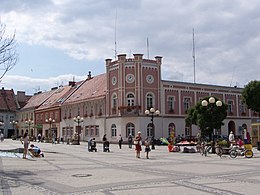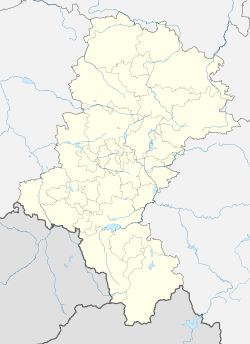Mikołów
Mikołów | |
|---|---|
 Market Square and Town Hall | |
| Coordinates:50°10′N18°54′E/ 50.167°N 18.900°E | |
| Country | |
| Voivodeship | |
| County | Mikołów |
| Gmina | Mikołów(urban gmina) |
| First mentioned | 1222 |
| Town rights | 1547 |
| Government | |
| • Mayor | Stanisław Piechula |
| Area | |
| • City | 79.2 km2(30.6 sq mi) |
| Population (2019-06-30[1]) | |
| • City | 40,898 |
| • Density | 520/km2(1,300/sq mi) |
| •Urban | 2,746,000 |
| •Metro | 5,294,000 |
| Time zone | UTC+1(CET) |
| • Summer (DST) | UTC+2(CEST) |
| Postal code | 43–190 to 43–197 |
| Area code | +48 32 |
| Car plates | SMI |
| Climate | Dfb |
| Primary airport | Katowice Airport |
| National roads | |
| Voivodeship roads | |
| Website | https://mikolow.eu/ |
Mikołów[miˈkɔwuf](‹See Tfd›German:Nikolai,Silesian:Mikołōw) is atowninSilesia,in southernPoland,near the city ofKatowice.Outer town of theMetropolis GZM,a metropolis with a population of over 2 million, and is within a greaterKatowice-Ostrava metropolitan areapopulated by about 5,294,000 people.[2]The population of the town is 40,898 (2019). Located in theSilesian Highlands,on theJamnastream, a tributary of theKłodnica Riverand indirectly theOder.
It is situated in theSilesian Voivodeshipsince its formation in 1999, previously inKatowice Voivodeship,and before then, of theSilesian Voivodeship.
History
[edit]This articleneeds additional citations forverification.(April 2008) |

With a written mention from 1222, Mikołów is one of the oldest towns inUpper Silesia.This was a document sent by dukeCasimir I of Opole(the son ofMieszko II the Fat) to the bishop ofWrocław,Wawrzyniec.In the document was written the name of Andrew (Latin:comes Andreas, castellanus de Miculow), the castellan ofMiculow,showing that Mikołów was already an administrative center. The town's name comes from the nameMikołaj( "Nicholas"), and is of Polish origin. As a result of the fragmentation of the medievalKingdom of Poland,Mikołów was part of theDuchy of Opole and Racibórz,still ruled by thePiast dynastyuntil 1532. During theOstsiedlung,Mikołów significantly grew in population and expanded its infrastructure.
Mikołów became the center of local trading, located on crossroads of trading roads. TheBlack Deathkilled 33% of the town's inhabitants in 1349–50. In the period 1433–1443, there were severalearthquakesin the area. In 1547 Mikołów gained city status. In 1580 the firstProtestantpastor came to the town, however, in 1630 the local parish returned to theCatholic Churchand its parish priest became Tomasz Aleksander Czarniecki. In 1645 and 1687 few fires burnt tenements near the market place and in connection with that Mikołów achieved the right to expose four fairs a year. In the second half of the 18th century peasants few times opposed the ruler and paying high serfdomes. Additionally in between 1713 and 1715 the city survived afaminebringing epidemics. Following the mid-18th-centurySilesian Warsthe town was annexed by theKingdom of Prussia.In 1760 the name "Mikołów" was used first time in the originally form. On 20 May 1794 a huge fire disaster burnt whole houses around the market square, including the town hall and all historical documents stored inside.

In the 19th century, the town became a center of Polish printing in Upper Silesia.[3]In 1845, Tomasz Nowacki founded a Polish printing house, and later on Polish activist and writer Karol Miarka published the Polish magazinesKatolikandMonikain the town.[3][4]Poles smuggled large amounts of gunpowder through the town to theRussian Partitionof Poland during theJanuary Uprisingin 1863.[5]In 1871 the town became part of theGerman Empire,where it was officially known under theGermanizednameNikolai.The town's predominantlyPolishpopulation referred to the town as bothMikułówandMikołów.[4]In 1908, the still-existing Polish choirHarmoniawas founded.[3]
AfterWorld War I,in 1918, Poland regained independence, and shortly after the PolishSilesian Uprisingswere fought and a plebiscite was held, in which the slight majority of the town opted with 55.2% in favor of remaining within Germany, while the overwhelming majority in the present-day districts (then surrounding villages) ofBorowa Wieś,Kamionka,Mokre,Śmiłowice,BujakówandPaniowyopted to reintegrate with Poland, with the result ranging from 72.2% voting for Poland in Bujaków to 94.4% in Kamionka.[6][7]The town was eventually reintegrated with Poland in 1922, where it officially became Mikołów. Within interwar Poland, the town was electrified, new schools were opened, a new post office, fire brigade and stadium were built, and a Polish library was founded.[8]
World War II
[edit]
During the Germaninvasion of Poland,which startedWorld War II,the town was captured by German troops on September 3, 1939. Mikołów was defended against the Germans jointly by thePolish Armyand civilians.[9]Due to Polish fortifications, the remainings of some pre-war Polish bunkers can be seen even today.
During the subsequentGerman occupation,the Polish population was subjected to mass arrests, murder, deportations toconcentration camps,expulsionsand forced conscriptions to theWehrmacht.[10]Already in early September 1939, the Germans carried out mass arrests and executions of former Polish insurgents of the Silesian Uprisings and local Polish activists.[11]Among the victims of massacres carried out on 5, 7 and 17 September 1939 were Polish workers, miners, craftsmen, a farmer, a court employee, a policeman, a merchant, and a local official.[12]The Germans also carried out manhunts of Polish insurgents who were hiding in the forest between Mikołów andTychy,[13]and destroyed the book collection of the pre-war Polish library.[8]
Nevertheless, local Poles quickly organized anunderground resistance movement,and Poles from Mikołów also fought in thePolish Armed Forces in the Westalong theWestern Allies.[10]16 Polish policemen from Mikołów were murdered by the Soviets inMednoyeduring the largeKatyn massacrein 1940.[14]In 1943, the Germans carried out expulsions of Poles.[15]In January 1945, the Germans murdered 14 members of the Polish resistance movement and 60 prisoners of theAuschwitz concentration campin Mikołów during adeath march,while in the present-day districts ofBorowa WieśandMokre,they murdered 31 and 13 prisoners respectively.[16]
In 1945–1950, many citizens were either deported to theSoviet Unionas forced labour orexpelledin accordance with thePotsdam Agreement.The town itself was restored to Poland. In the years after the war, as the surviving pre-war Polish population, was joined by Poles from East and Central Poland.
Jewish history
[edit]The firstJewsappeared in Mikołów in 1674, establishing an inn. Thesynagoguein Mikołów was established in 1816. There was about 800 Jews in the town in the second half of the 19th century. Since then the number of Jewish inhabitants little by little has been lowering down to the level of 243 before theSecond World War.Just before the liberation bySovietsin January 1945, prisoners fromAuschwitzhad marched through Mikołów to Germany to work in labour camps. They were totally exhausted and weak, most of them were at the death's door. In Mikołów over 60 people died or were murdered and then buried in the Jewish cemetery. Among the prisoners were also someCatholics.In 1972 thecommunistauthority ordered the miners from the coalmineBolesław Śmiałyto detonate the Synagogue.
The Jewish cemetery in Mikołów was established at the end of the 19th century, but the oldest tomb dates back to 1726. Only 100 of 265 tombs are preserved. In the front of the cemetery is the memorial, dedicated to the victims of January 1945. On the memorial there is written: "In this place rest in peace 14 people shot up on 16 January 1945 bySchutzpolizeiofficers, and 50 prisoners from the concentration camp in Auschwitz, murdered on 19 January 1945 during evacuation of the camp by Germans. Glory to them "
In Mikołów there was also located another-older Jewish cemetery (1682) but during the Second World War it was completely ruined.
Districts
[edit]Apart from the town proper Mikołów has one distinct district (Kamionka) and 5sołectwos:[17]

Notable people
[edit]
- Joseph Abraham Steblicki(c. 1726–1807), teacher and treasurer
- Ignaz Wechselmann(1828–1903), Hungarian architect and philanthropist
- Georg Zeumer(1890–1917),World War Ifighter pilot
- Rafał Wojaczek(1945–1971), poet
- Eugeniusz Wycisło(born 1948), politician
- Izabela Kloc(born 1963), politician
- Roksana Jonek(born 1978),Miss Polonia1997
- Anna Dereszowska(born 1981), actress and singer
Twin towns – sister cities
[edit] Beuningen,Netherlands
Beuningen,Netherlands Ilava,Slovakia
Ilava,Slovakia Klimkovice,Czech Republic
Klimkovice,Czech Republic Sainte-Geneviève-des-Bois,France
Sainte-Geneviève-des-Bois,France
References
[edit]- ^"Population. Size and structure and vital statistics in Poland by territorial division in 2019. As of 30th June".stat.gov.pl.Statistics Poland. 2019-10-15.Retrieved2020-03-13.
- ^European Spatial Planning Observation Network(ESPON)"Project 1.4.3".Archived fromthe originalon 2009-07-28.Retrieved2009-03-28.
- ^abc"Stolica drukarstwa".Gmina Mikołów(in Polish).Retrieved21 November2020.
- ^abSłownik geograficzny Królestwa Polskiego i innych krajów słowiańskich, Tom VI(in Polish). Warszawa. 1885. p. 414.
{{cite book}}:CS1 maint: location missing publisher (link) - ^Pater, Mieczysław (1963). "Wrocławskie echa powstania styczniowego".Śląski Kwartalnik Historyczny Sobótka(in Polish) (4): 418.
- ^"Results of the Upper Silesia plebiscite in Pless/Pszczyna County"(in German). Archived fromthe originalon 2015-05-02.
- ^"Results of the Upper Silesia plebiscite in Hindenburg/Zabrze County"(in German). Archived fromthe originalon 2016-03-04.
- ^ab"Polscy ułani na mikołowskim rynku".Gmina Mikołów(in Polish).Retrieved21 November2020.
- ^Wardzyńska, Maria (2009).Był rok 1939. Operacja niemieckiej policji bezpieczeństwa w Polsce. Intelligenzaktion(in Polish). Warszawa:IPN.p. 128.
- ^ab"Po dwóch stronach frontu".Gmina Mikołów(in Polish).Retrieved21 November2020.
- ^Wardzyńska (2009), p. 131
- ^Wardzyńska (2009), p. 132
- ^Wardzyńska (2009), p. 119
- ^"Pamięci ofiar Katynia i Smoleńska".Gazeta Mikołowska(in Polish).Retrieved21 November2020.
- ^Wardzyńska, Maria (2017).Wysiedlenia ludności polskiej z okupowanych ziem polskich włączonych do III Rzeszy w latach 1939–1945(in Polish). Warszawa: IPN. p. 459.ISBN978-83-8098-174-4.
- ^"Szlakiem Marszów Śmierci".Miejsce Pamięci i Muzeum Auschwitz-Birkenau(in Polish).Retrieved21 November2020.
- ^"Jednostki pomocnicze"(in Polish).Retrieved2015-05-06.
- ^"Miasta partnerskie".mojmikolow.pl(in Polish). Mikołów.Retrieved2020-03-13.
External links
[edit]- Mikołów government website
- Jewish Community in Mikołówon Virtual Shtetl




